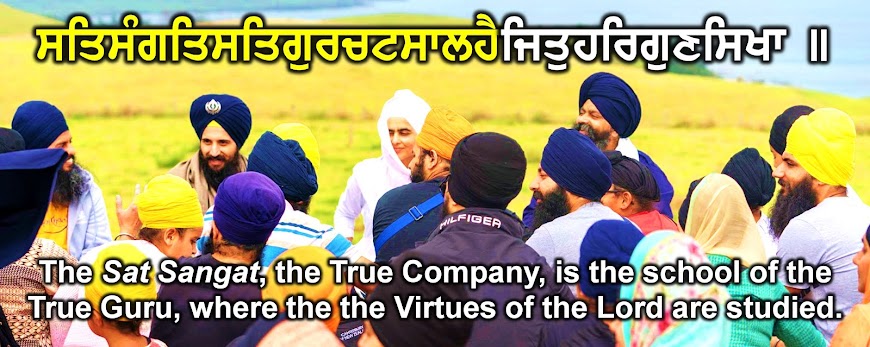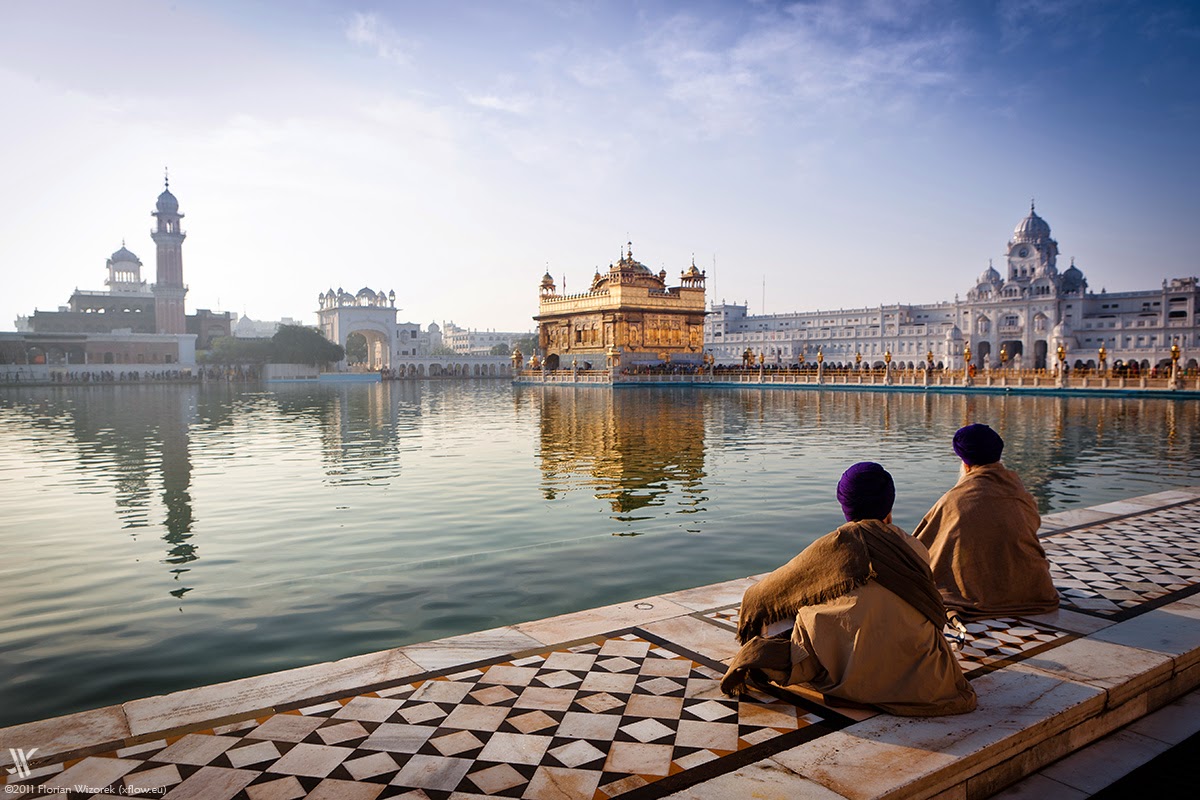Continued...
#2. "Why do some Amritdharis only eat and cook in Sarbloh?"
#3. "Just by keeping Bibek or eating out of Sarbloh is not going to liberate you."
RESPONSE: Sri
Guru Granth Sahib Ji doesn't mention having a Nishaan Sahib erected
outside a Gurdwara Sahib, saying "Fateh", or eating Pizza or ice-cream
but no one questions these things. So why does Sarbloh need to be
mentioned in Sri Guru Granth Sahib Ji? Sarbloh has existed and been
used since the times of the Guru Sahibaans. Sarbloh utensils are still
used for cooking Langar at Sri Harmandir Sahib, Amritsar. Up until the
1960s, Sarbloh utensils were given to Sangat to eat Langar as well.
However, they were replaced with steel trays in the name of modernity,
and now there are some Gurdwaras in the world that have modernised
further by using plastic disposable plates (which is bad for the
environment and one's health!).
#2. "Why do some Amritdharis only eat and cook in Sarbloh?"
RESPONSE: 'Sarbloh Bibek' or the all iron quality is a strict Rehat (discipline) practised by strict Sikhs and Akali Nihangs. It is one of the paramount definitions of the Khalsa Panth and involves the consumption of edibles strictly from Sarbloh utensils. In Sikh tradition, Sarbloh (all-iron) is prized above other metals due to it being multi-functional and a scientifically beneficial element. It inhibits the food placed in it and adds minerals to it which not only nourish but strengthen the body. Often the historic Sikhs, who strictly payed adherence to this Rehat were described as having bodies like of rock.
The fact that the day we took Amrit, we were instructed by Guru Ji to wear a Sarbloh Karha and Sarbloh Kirpan stresses the importance of Sarbloh. Furthermore, Guru Gobind Singh Ji made the decision to prepare Amrit in a Sarbloh utensil. Guru Ji had at his disposal gold, silver and other precious metals but he chose Sarbloh for this purpose. He loved this metal - Sarbloh - so much that he even called Vaheguru by this name as is evident if we look at the starting of his Baani 'Akaal Ustat'. Someone is reminded of their birthday every time they eat in Sarbloh. The Sarbloh Baattaa they are eating from is the same Sarbloh which gave them life and made them reborn as the Khalsa.
The fact that the day we took Amrit, we were instructed by Guru Ji to wear a Sarbloh Karha and Sarbloh Kirpan stresses the importance of Sarbloh. Furthermore, Guru Gobind Singh Ji made the decision to prepare Amrit in a Sarbloh utensil. Guru Ji had at his disposal gold, silver and other precious metals but he chose Sarbloh for this purpose. He loved this metal - Sarbloh - so much that he even called Vaheguru by this name as is evident if we look at the starting of his Baani 'Akaal Ustat'. Someone is reminded of their birthday every time they eat in Sarbloh. The Sarbloh Baattaa they are eating from is the same Sarbloh which gave them life and made them reborn as the Khalsa.
"Often in the need for modernization and appeal the discoveries and ingenuity of the ancestors are forgotten and man places his well-being straight into the fangs of death. Compared to aluminium, a substantial component of the utensil industry, iron does not possess any lethal effects to the health and has a far more beneficent effect than the nullified stainless steel, which is becoming extensively employed by many home-goods manufacturers. On a much perceptive scale however iron is famed, amongst the orthodox Sikhs, for it's ability to retain vibration. Along with being a natural conductor, iron retains extensively high-pitched vibrations in it's structure which according to spiritual scientists are passed onto it's user. In simple terms this allows an orthodox Sikh to influence orthodoxy amongst his fellow Sikhs by feeding them in iron. Human emotions are obviously expressed via sound and as such the vibrations are retained by iron, an orthodox Sikh would surely recite non-specific passages from Gurbani and/or chant 'Vaheguru' which would birth the same spiritual emotions in a fellow Sikh; who would consume food from his hands in iron utensils.
A great number of historical Sikh figures have followed 'Sarbloh Bibek.' They would strengthen their mind and exist in a high spiritual state where, despite remaining unaffected by the world, they heavily influenced particular events. Such Sikhs would only consume food cooked by themselves, by Sikhs on a similar spiritual level or forego the need for food unless their requirements were met. Among their ranks the names of Bhai Randhir Singh Ji, Sant Giani Gurbachan Singh Ji Khalsa Bhindranwale and Shaheed Akali Nihung Avtar Singh. These individuals were noted for their vitality, even in their senior years, and their exceptional stamina in the face of grudging odds. All credit for their physical and mental finesse lies with Gurbani, Rehat and 'Sarbloh Bibek.' Their lives are evident of how a supernatural sensitivity arises in orthodox individuals who are affected even by the slightest currents in the micro-organismic and/or spiritual prism. They gain the ability to retain and analyze the unspoken thoughts and intentions of their fellows. As such they will be heavily affected and tired out by the thoughts of egocentric individuals whose selfishness will not cease, thus they will avoid the company and items of such individuals.
In conclusion one can easily summarize 'Sarbloh Bibek' as being an exclusive practice which does not seek to stratify but discipline an individual bent upon adopting a spiritual lifestyle. It serves as a medicinal aid, a scientific benefit and a spiritual moral booster. Aspects heavily required in today's time by saints. One should identify and analyze it's importance before dispelling it as being of no consequence, only then can it retain it's exclusive prominence in the panth. Otherwise it is doomed to ignorance."(Taken from: http://tisarpanth.blogspot.co.uk/2013/05/sarbloh-bibek.html)
#3. "Just by keeping Bibek or eating out of Sarbloh is not going to liberate you."
RESPONSE: True.
Just by wearing a Kirpaan or Kachhera you are not going to get
Sachkhand either. However, I don't think we expect people to take off
their Kakkaars. External Rehat or Bibek is an "aid" (ਸਹਾਇਕ ਕਰਮ)
that helps us to experience and connect with Naam. Naam will only save
us and liberate us. However, we have to follow a discipline and create
an environment where Naam can be cultivated and grow within us. Wearing
Panj Kakkaar, dietary bibek (eating from the hands of Amritdhari),
eating in Sarbloh, giving Daswandh, wearing Bana (Khalsa attire) etc,
all help us to remember Guru Ji and to maintain Guru consciousness which
helps to remind us to stay focus on Guru Ji and Naam. Our Rehat and
actions only have value if they are connected to Naam and have the
purpose of brining us closer to Naam. Otherwise our actions or Rehat can
easily become false (Pakhand). Guru Ji says:
ਗਿਆਨੁ ਧਿਆਨੁ ਸਭੁ ਗੁਰ ਤੇ ਹੋਈ || ਸਾਚੀ ਰਹਤ ਸਾਚਾ ਮਨਿ ਸੋਈ ||
ਮਨਮੁਖ ਕਥਨੀ ਹੈ ਪਰੁ ਰਹਤ ਨ ਹੋਈ || ਨਾਵਹੁ ਭੂਲੇ ਥਾਉ ਨ ਕੋਈ ||੩||
"Spiritual wisdom and meditation all come from the Guru. Through the lifestyle of Truth, the True Lord comes to dwell in the mind. The self-willed manmukh talks about it, but does not practice it. Forgetting the Name, he finds no place of rest. ||3||"
(Bilaaval M:1, 831)


.JPG)































